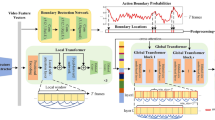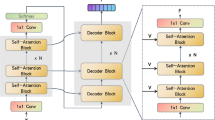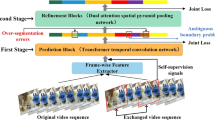Abstract
Action segmentation involves locating and classifying human action segments in an untrimmed video, which is very important for understanding human activities. Segmenting actions in the video is a very challenging task due to the problem of ambiguous frames. Previous studies on this topic usually required additional inputs or constructed highly complicated network structures to achieve good performance. However, these additional inputs are not easy to obtain, and complicated network structures increase the costs of computation and storage. Hence, to mitigate these problems, we propose a bottom-up improved multistage temporal convolutional network (BUIMS-TCN) for action segmentation. Specifically, we first propose a smoothed dilated 1D convolution to learn the inherent local temporal dependencies. Second, we design an adaptive temporal fusion module (ATFM), which is a simple yet effective multiscale temporal-context information fusion module, to obtain better semantic feature representations. Finally, we introduce a new loss function to solve the imbalance between easy and hard samples. To the best of our knowledge, this is the first time that the above improvements have been incorporated into the action segmentation task. Extensive experiments verify that our model significantly outperforms the state-of-the-art baselines on three challenging benchmark datasets: Georgia Tech Egocentric Activities (GTEA), 50Salads, and the Breakfast dataset.








Similar content being viewed by others
References
Wang Z, Gao Z, Wang L, Li Z, Wu G (2020) Boundary-Aware Cascade Networks for Temporal Action Segmentation. In: European Conference on Computer Vision (ECCV), pp 34–51
Ahmed M, Mahmood AN, Hu J (2016) A survey of network anomaly detection techniques. J Netw Comput Appl 60:19–31
Liu H, Fang S, Zhang Z, Li D, Lin K, Wang J (2021) MFDNet: collaborative poses perception and matrix fisher distribution for head pose estimation. IEEE Transactions on Multimedia:1–1
Li D, Liu H, Zhang Z, Lin K, Fang S, Li Z, Xiong NN (2021) CARM: confidence-aware recommender model via review representation learning and historical rating behavior in the online platforms. Neurocomputing 455:283–296
Shen X, Yi B, Liu H, Zhang W, Zhang Z, Liu S et al (2021) Deep Variational matrix factorization with knowledge embedding for recommendation system. IEEE Trans Knowl Data Eng 33:1906–1918
Liu T, Liu H, Li Y, Zhang Z, Liu S (2019) Efficient blind signal reconstruction with wavelet transforms regularization for educational robot infrared vision sensing. IEEE/ASME Transactions on Mechatronics 24:384–394
Liu T, Liu H, Li Y, Chen Z, Zhang Z-l, Liu S (2020) Flexible FTIR spectral imaging enhancement for industrial robot infrared vision sensing. IEEE Transactions on Industrial Informatics 16:544–554
Xu B, Ye H, Zheng Y, Wang H, Luwang T, Jiang Y (2019) Dense dilated network for video action recognition. IEEE Trans Image Process 28:4941–4953
Feichtenhofer C, Pinz A, Wildes R (2016) Spatiotemporal residual networks for video action recognition. In: Advances in Neural Information Processing Systems (NIPS), pp 3468–3476
Carreira J, Zisserman A (2017) Quo Vadis, Action Recognition? A New Model and the Kinetics Dataset. In: 2017 IEEE Conference on Computer Vision and Pattern Recognition (CVPR), pp 4724–4733
Feichtenhofer C, Fan H, Malik J, He K (2019) SlowFast Networks for Video Recognition. In: 2019 IEEE/CVF International Conference on Computer Vision (ICCV), pp 6201–6210
Zhang X, Huang Y, Mi Y, Pei Y, Zou Q, Wang S (2021) Video sketch: a middle-level representation for action recognition. Appl Intell 51:2589–2608
Yao G, Lei T, Zhong J, Jiang P (2018) Learning multi-temporal-scale deep information for action recognition. Appl Intell 49:2017–2029
Majd M, Safabakhsh R (2018) A motion-aware ConvLSTM network for action recognition. Appl Intell 49:2515–2521
Ding C, Liu K, Cheng F, Belyaev E (2020) Spatio-temporal attention on manifold space for 3D human action recognition. Appl Intell 51:560–570
Chen M-H, Li B, Bao SY-Z, Al-Regib G, Kira Z (2020) Action Segmentation With Joint Self-Supervised Temporal Domain Adaptation. In: 2020 IEEE/CVF Conference on Computer Vision and Pattern Recognition (CVPR), pp 9451–9460
Li S, Farha YA, Liu Y, Cheng M-M, Gall J (2020) MS-TCN++: multi-stage temporal convolutional network for action segmentation. IEEE Trans Pattern Anal Mach Intell PP:1
Lea CS, Flynn MD, Vidal R, Reiter A, Hager G (2017) Temporal Convolutional Networks for Action Segmentation and Detection. In: 2017 IEEE Conference on Computer Vision and Pattern Recognition (CVPR), pp 1003–1012
Gao J, Chen K, Nevatia R (2018) Ctap: Complementary temporal action proposal generation. In: European conference on computer vision (ECCV), pp 68–83
Hendry, Chen RC (2019) Automatic License Plate Recognition via sliding-window darknet-YOLO deep learning. Image Vis. Comput 87:47–56
Lea C, Reiter A, Vidal R, Hager GD (2016) Segmental spatiotemporal CNNs for fine-grained action segmentation. In: European Conference on Computer Vision (ECCV), pp 36–52
Richard A, Kuehne H, Gall J (2018) Action Sets: Weakly Supervised Action Segmentation Without Ordering Constraints. In: 2018 IEEE/CVF Conference on Computer Vision and Pattern Recognition (CVPR), pp 5987–5996
Kuehne H, Gall J, Serre T (2016) An end-to-end generative framework for video segmentation and recognition. In: 2016 IEEE Winter Conference on Applications of Computer Vision (WACV), pp 1–8
Farha YA, Gall J (2019) MS-TCN: Multi-Stage Temporal Convolutional Network for Action Segmentation. In: 2019 IEEE/CVF Conference on Computer Vision and Pattern Recognition (CVPR), pp 3570–3579
Ishikawa Y, Kasai S, Aoki Y, Kataoka H (2021) Alleviating Over-segmentation Errors by Detecting Action Boundaries. In: 2021 IEEE Winter Conference on Applications of Computer Vision (WACV), pp 2321–2330
Chen L-C, Papandreou G, Kokkinos I, Murphy K, Yuille A (2018) DeepLab: semantic image segmentation with deep convolutional nets, Atrous convolution, and fully connected CRFs. IEEE Trans Pattern Anal Mach Intell 40:834–848
Wang P, Chen P, Yuan Y, Liu D, Huang Z, Hou X et al (2018) Understanding Convolution for Semantic Segmentation. In: 2018 IEEE Winter Conference on Applications of Computer Vision (WACV), pp 1451–1460
Hamaguchi R, Fujita A, Nemoto K, Imaizumi T, Hikosaka S (2018) Effective Use of Dilated Convolutions for Segmenting Small Object Instances in Remote Sensing Imagery. In: 2018 IEEE Winter Conference on Applications of Computer Vision (WACV), pp 1442–1450
Wang Z, Ji S (2021) Smoothed dilated convolutions for improved dense prediction. Data Min Knowl Disc 35:1–27
Wu T, Tang S, Zhang R, Cao J, Li J (2019) Tree-Structured Kronecker Convolutional Network for Semantic Segmentation. In: 2019 IEEE International Conference on Multimedia and Expo (ICME), pp 940–945
Yu F, Koltun V, Funkhouser T (2017) Dilated Residual Networks. In: 2017 IEEE Conference on Computer Vision and Pattern Recognition (CVPR), pp 636–644
L.-C. Chen, G. Papandreou, F. Schroff, and H. Adam, "Rethinking Atrous Convolution for Semantic Image Segmentation," ArXiv, vol. abs/1706.05587, 2017
Guo C, Fan B, Zhang Q, Xiang S, Pan C (2020) AugFPN: Improving Multi-Scale Feature Learning for Object Detection. In: 2020 IEEE/CVF Conference on Computer Vision and Pattern Recognition (CVPR), pp 12592–12601
Lin T-Y, Goyal P, Girshick RB, He K, Dollár P (2020) Focal loss for dense object detection. IEEE Trans Pattern Anal Mach Intell 42:318–327
Fathi A, Ren X, Rehg JM (2011) Learning to recognize objects in egocentric activities. In: 2011 IEEE/CVF Conference on Computer Vision and Pattern Recognition (CVPR), pp 3281–3288
Stein S, McKenna S (2013) Combining embedded accelerometers with computer vision for recognizing food preparation activities. In: Proceedings of the 2013 ACM international joint conference on Pervasive and ubiquitous computing, pp 729–738
Kuehne H, Arslan AB, Serre T (2014) The Language of Actions: Recovering the Syntax and Semantics of Goal-Directed Human Activities. In: 2014 IEEE Conference on Computer Vision and Pattern Recognition, pp 780–787
Liu H, Nie H, Zhang Z, Li Y (2021) Anisotropic angle distribution learning for head pose estimation and attention understanding in human-computer interaction. Neurocomputing 433:310–322
Li Z, Liu H, Zhang Z, Liu T, Xiong NN (2021) Learning knowledge graph embedding with heterogeneous relation attention networks. IEEE Transactions on Neural Networks and Learning Systems
Zhang Z, Li Z, Liu H, Xiong NN (2020) Multi-scale dynamic convolutional network for knowledge graph embedding. IEEE Ann Hist Comput:1
Lei P, Todorovic S (2018) Temporal Deformable Residual Networks for Action Segmentation in Videos. In: 2018 IEEE/CVF Conference on Computer Vision and Pattern Recognition, pp 6742–6751
Ding L, Xu C (2018) Weakly-Supervised Action Segmentation with Iterative Soft Boundary Assignment. In: 2018 IEEE/CVF Conference on Computer Vision and Pattern Recognition, pp 6508–6516
Singh B, Marks TK, Jones MJ, Tuzel O, Shao M (2016) A Multi-stream Bi-directional Recurrent Neural Network for Fine-Grained Action Detection. In: 2016 IEEE Conference on Computer Vision and Pattern Recognition (CVPR), pp 1961–1970
Richard A, Kuehne H, Gall J (2017) Weakly Supervised Action Learning with RNN Based Fine-to-Coarse Modeling. In: 2017 IEEE Conference on Computer Vision and Pattern Recognition (CVPR), pp 1273–1282
Kuehne H, Richard A, Gall J (2020) A hybrid RNN-HMM approach for weakly supervised temporal action segmentation. IEEE Trans Pattern Anal Mach Intell 42:765–779
Richard A, Gall J (2016) Temporal Action Detection Using a Statistical Language Model. In: 2016 IEEE Conference on Computer Vision and Pattern Recognition (CVPR), pp 3131–3140
Mac K-NC, Joshi D, Yeh RA, Xiong J, Feris R, Do M (2019) Learning Motion in Feature Space: Locally-Consistent Deformable Convolution Networks for Fine-Grained Action Detection. In: 2019 IEEE/CVF International Conference on Computer Vision (ICCV), pp 6281–6290
Kuehne H, Richard A, Gall J (2017) Weakly supervised learning of actions from transcripts. Comput Vis Image Underst 163:78–89
Li Y, Chen Y, Wang N, Zhang Z (2019) Scale-aware trident networks for object detection. In: IEEE/CVF International Conference on Computer Vision (CVPR), pp 6054–6063
Dai J, Li Y, He K, Sun J (2016) R-fcn: Object detection via region-based fully convolutional networks. In: Advances in Neural Information Processing Systems (NIPS), pp 379–387
Shelhamer E, Long J, Darrell T (2017) Fully convolutional networks for semantic segmentation. IEEE Trans Pattern Anal Mach Intell 39:640–651
Vo DM, Lee S-W (2018) Semantic image segmentation using fully convolutional neural networks with multi-scale images and multi-scale dilated convolutions. Multimed Tools Appl 77:18689–18707
Zhang H, Dana K, Shi J, Zhang Z, Wang X, Tyagi A et al (2018) Context Encoding for Semantic Segmentation. In: 2018 IEEE/CVF Conference on Computer Vision and Pattern Recognition (CVPR), pp 7151–7160
Islam MA, Rochan M, Bruce NDB, Wang Y (2017) Gated Feedback Refinement Network for Dense Image Labeling. In: 2017 IEEE Conference on Computer Vision and Pattern Recognition (CVPR), pp 4877–4885
O. Ronneberger, P. Fischer, and T. Brox, "U-net: convolutional networks for biomedical image segmentation," in MICCAI, 2015
Lin G, Milan A, Shen C, Reid I (2017) RefineNet: Multi-path Refinement Networks for High-Resolution Semantic Segmentation. In: 2017 IEEE Conference on Computer Vision and Pattern Recognition (CVPR), pp 5168–5177
Chen L-C, Zhu Y, Papandreou G, Schroff F, Adam H (2018) Encoder-decoder with atrous separable convolution for semantic image segmentation. In: European Conference on Computer Vision (ECCV), pp 801–818
Redmon J, Divvala S, Girshick RB, Farhadi A (2016) You Only Look Once: Unified, Real-Time Object Detection. In: 2016 IEEE Conference on Computer Vision and Pattern Recognition (CVPR), pp 779–788
Redmon J, Farhadi A (2017) YOLO9000: Better, Faster, Stronger. In: 2017 IEEE Conference on Computer Vision and Pattern Recognition (CVPR), pp 6517–6525
Liu W, Anguelov D, Erhan D, Szegedy C, Reed SE, Fu C-Y et al (2016) SSD: Single Shot MultiBox Detector. In: European Conference on Computer Vision (ECCV), pp 21–37
Chen Y, Li W, Sakaridis C, Dai D, Van Gool L (2018) Domain adaptive faster r-cnn for object detection in the wild. In: IEEE Conference on Computer Vision and Pattern Recognition (CVPR), pp 3339–3348
He K, Gkioxari G, Dollár P, Girshick RB (2020) Mask R-CNN. IEEE Trans Pattern Anal Mach Intell 42:386–397
Lin T-Y, Dollár P, Girshick RB, He K, Hariharan B, Belongie SJ (2017) Feature Pyramid Networks for Object Detection. In: 2017 IEEE Conference on Computer Vision and Pattern Recognition (CVPR), pp 936–944
Shrivastava A, Gupta A, Girshick RB (2016) Training Region-Based Object Detectors with Online Hard Example Mining. In: 2016 IEEE Conference on Computer Vision and Pattern Recognition (CVPR), pp 761–769
Bulò SR, Neuhold G, Kontschieder P (2017) Loss Max-Pooling for Semantic Image Segmentation. In: 2017 IEEE Conference on Computer Vision and Pattern Recognition (CVPR), pp 7082–7091
Li B, Liu Y, Wang X (2019) Gradient harmonized single-stage detector. In: Proceedings of the AAAI Conference on Artificial Intelligence, pp 8577–8584
Chollet F (2017) Xception: Deep Learning with Depthwise Separable Convolutions. In: 2017 IEEE Conference on Computer Vision and Pattern Recognition (CVPR), pp 1800–1807
Lea CS, Vidal R, Hager G (2016) Learning convolutional action primitives for fine-grained action recognition. In: 2016 IEEE International Conference on Robotics and Automation (ICRA), pp 1642–1649
He K, Zhang X, Ren S, Sun J (2016) Deep Residual Learning for Image Recognition. In: 2016 IEEE Conference on Computer Vision and Pattern Recognition (CVPR), pp 770–778
Acknowledgments
This work was supported in part by the National Natural Science Foundation of China under Grants 61907007 and 62107009, in part by the National Key R&D Program of China under Grant 2020YFA0714102, in part by the Fund of the Jilin Provincial Science and Technology Department under Grants 20210201077GX, 20200201199JC, 20200401086GX and 20200401081GX, and in part by the Fundamental Research Funds for the Central Universities under Grants 2412020FZ029, 2412020FZ031, and 2412019FZ049.
Author information
Authors and Affiliations
Corresponding authors
Additional information
Publisher’s note
Springer Nature remains neutral with regard to jurisdictional claims in published maps and institutional affiliations.
Supplementary Information
ESM 1
(DOCX 188 kb)
Rights and permissions
About this article
Cite this article
Chen, W., Chai, Y., Qi, M. et al. Bottom-up improved multistage temporal convolutional network for action segmentation. Appl Intell 52, 14053–14069 (2022). https://doi.org/10.1007/s10489-022-03382-x
Accepted:
Published:
Issue Date:
DOI: https://doi.org/10.1007/s10489-022-03382-x




